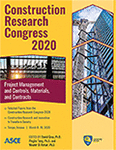Construction Research Congress 2020
Utilizing Graphite Powder to Improve Concrete Conductivity, Compressive Strength, and Workability
Publication: Construction Research Congress 2020: Project Management and Controls, Materials, and Contracts
ABSTRACT
Electrically conductive concrete (ECC) has been suggested to be used in cold areas for deicing snow on highway roads and city streets. The following study investigates the impact of graphite as supplementary cementitious material on concrete conductivity to aid future research developing ECC. In addition, the study investigates the impact of graphite on compressive strength and workability. Accordingly, three concrete mixes that include three different percentages of graphite and a control mix have been prepared in the lab to achieve the study objectives. American Society of Testing Materials’ (ASTM) compressive and slump tests were performed. In addition, two-point conductivity measurements were made at days 1, 2, 7, and 28 of the concrete curing. Concrete workability was greatly affected, negatively, with all levels of graphite. Compressive test results indicate that an optimum level of graphite is realized to provide maximum compressive strength. Measured electrical resistance decreased, thus conductivity increased, in samples containing 0.5% and 1% graphite as compared to the control. However, conductivity decreased in graphite levels above the 1% graphite mark, indicating a design optimization level of graphite. Finally, a scanning electron microscope (SEM) was employed to explain conductivity differences in samples with various pore sizes.
Get full access to this article
View all available purchase options and get full access to this chapter.
REFERENCES
Aït-Mokhtar, A., Belarbi, R., Benboudjema, F., Burlion, N., Capra, B., Carcassès, M., Colliat, J.-B., Cussigh, F., Deby, F., Jacquemot, F., de Larrard, T., Bescop, P. L., J.-F.Pierre, M., Poyet, S., Rougeau, P., Rougelot, T., Sellier, A., Semenadisse, J., Torrenti, J.-M., Trabelsi, A., Turcry, P., and Yanez-Godoy, H. (2013). “Experimental investigation of the variability of concrete durability properties” Cement and Concrete Research, 45, 21 – 36.
Abdualla, H., Ceylan, H., kim, S., Gopalakrishan, K., Taylor, P., Turkan, Y. (2015). “System Requirements for Electrically Conductive Concrete Heated Pavements.” Journal of the Transportation Research Board, 2569:70-79
Kamali, M., and Ghahremaninezhad, A. (2017) “An investigation into the influence of superabsorbent polymers on the properties of glass powder modified cement pastes,” Construction and Building Materials, 149, 236–247
Kosmatka, S. H., Kerkhoff, B., and Panarese, W. C. (2003). “Design and Control of Concrete Mixtures.” 14th edition, Portland Cement Association (PCA), Skokie, Illinois, USA
Li, W., Li, X., Chen, S. J., Liu, Y. M., Duan, W. H., and Shah, S. P., (2017). “Effects of graphene oxide on early-age hydration and electrical resistivity of portland cement paste.” Construction and Building Materials, 136, 506 – 514
Liu. Q., Xu, Q., Yu, Q., Gao, R., and Tong, T. (2016). “Experimental investigation on mechanical and piezoresistive properties of cementitious materials containing graphene and graphene oxide nanoplatelets” Construction and Building Materials, 127, 565 – 576
Lu, X. (1997). “Application of the nernst-einstein equation to concrete,” Cement and Concrete Research, 27(2), 293 – 302
Lu¨beck, A., Gastaldini, A., Barin, D., and Siqueira, H. (2012). “Compressive strength and electrical properties of concrete with white portland cement and blast-furnace slag,” Cement and Concrete Composites, 34 (3), 392 – 399
Medeiros-Junior, R. A. and Lima, M. G. (2016) “Electrical resistivity of unsaturated concrete using different types of cement,” Construction and Building Materials, 107, 11–16
Shi, C. (2004). “Effect of mixing proportions of concrete on its electrical conductivity and the rapid chloride permeability test (astm c1202 or asshto t277) results,” Cement and Concrete Research, 34 (3), 537 – 545
Wang, Z., Zeng, Q., Wang, L., Yao, Y., and Li, K. (2013). “Characterizing blended cement pastes under cyclic freeze–thaw actions by electrical resistivity,” Construction and Building Materials, 44, 477 – 486.
Information & Authors
Information
Published In
Construction Research Congress 2020: Project Management and Controls, Materials, and Contracts
Pages: 881 - 888
Editors: David Grau, Ph.D., Arizona State University, Pingbo Tang, Ph.D., Arizona State University, and Mounir El Asmar, Ph.D., Arizona State University
ISBN (Online): 978-0-7844-8288-9
Copyright
© 2020 American Society of Civil Engineers.
History
Published online: Nov 9, 2020
Published in print: Nov 9, 2020
Authors
Metrics & Citations
Metrics
Citations
Download citation
If you have the appropriate software installed, you can download article citation data to the citation manager of your choice. Simply select your manager software from the list below and click Download.
